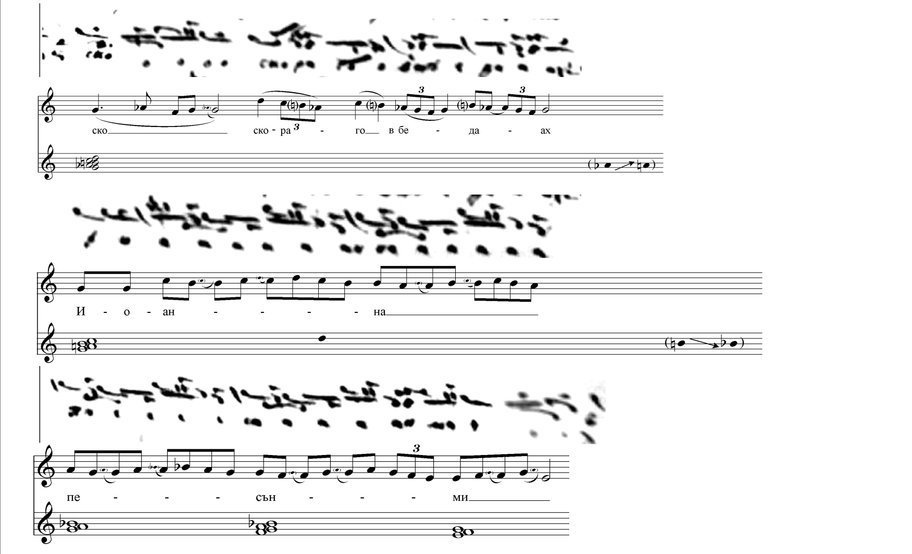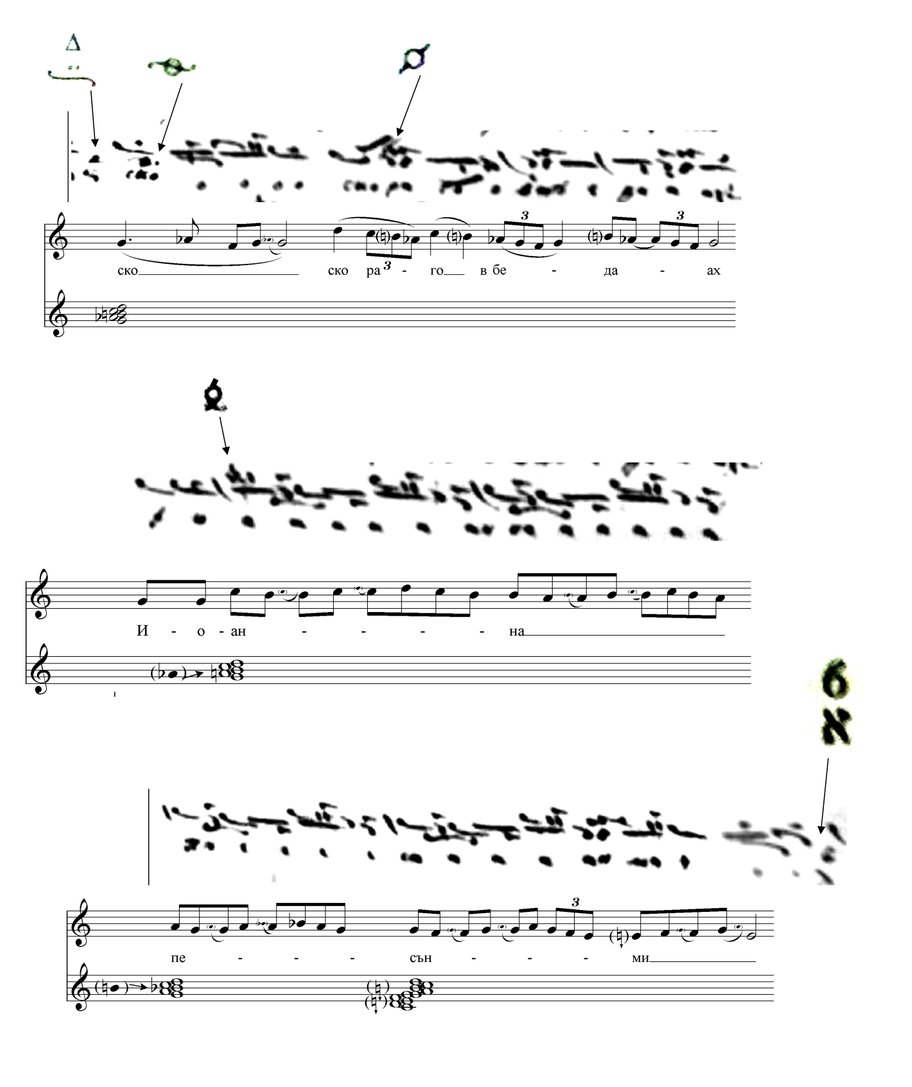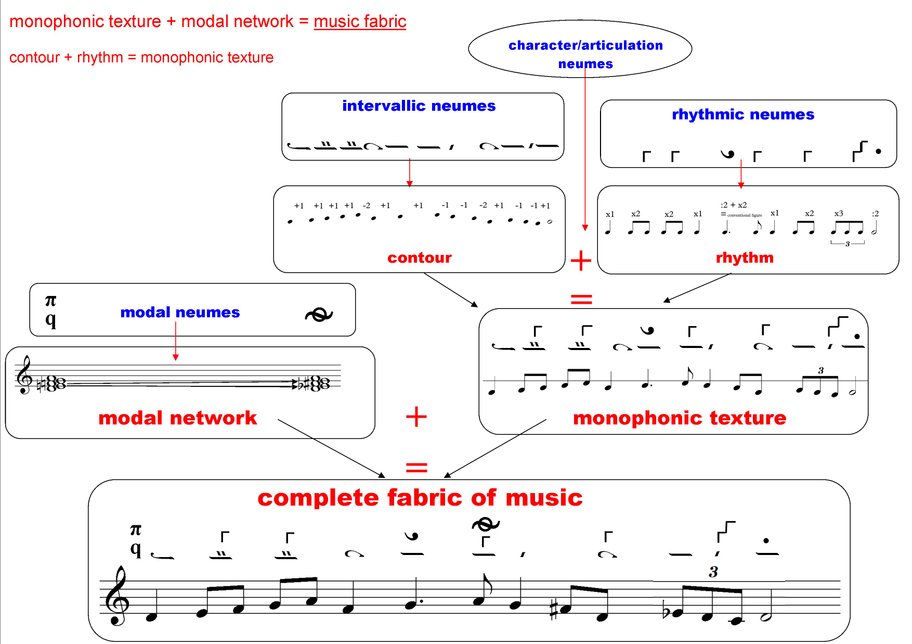Figure 4: Excerpt from Херувимска Песен (Cheroubikon) by Hieromonk Athanasius of Rila, after Petros the Lampadarios.44 (click) Stave transcription and pitch collection summary.
____________________________________________
This short excerpt illustrates the occurrence of fluctuation45 (click) on b. Although this kind of fluctuation in the tradition is far from limited to the position of zo, and can occur at many other positions in the network, the fluctuation on the zo (b) is particularly typical.
These two very short excerpts are just a very brief illustration of the very complex practice of monophonic modal modulation and expressive melodic inflection in Eastern Chant. It will become clear that they are particularly relevant to my working method, but it would be beyond the scope of this study to enter in further detail about the general features of this practice theoretically or historically. Suffice it to say that the foundations of this modulation practice go back to Classical Antiquity and that a detailed theoretical development of this kind of modal modulations – metabolē, as well as its employment in notated music specimens from Ancient Greece has survived and has been extensively researched.46 (click) Later, in the Byzantine period, exactly the same kind of modal modulativity is evident even in the earliest Paleo-Byzantine music manuscripts,47 (click) 48 (click) and is referred to even in the earliest medieval theoretical treatise(s) on Byzantine music that we are aware of today.49 (click) Detailed theoretical discussions of the metabolē practice occur in later Byzantine and post-Byzantine treatises50 (click) all the way down to Chrysanthos (nineteenth century)51 (click) and into the contemporary singer’s manuals of the present day. The modulation practice is codified in the notation, as exemplified above, and its understanding is essential to even the basic level of singing from neumatic notation.
I must underline that this is a theory and practice of monophonic harmony and monophonic modal modulation.
Similar monophonic modulativity is present in several other traditions. Contemporary Arab,52 (click) Turkish53 (click) and Persian54 (click) practices exhibit similarities of particular prominence. It has been ascertained by Sultan55 (click) that in Turkish and Persian music these specifics are directly based on the Ancient Greek practice.56 (click) The Ancient Greek roots and Byzantine influences upon the maqamat system are discussed thoroughly by Shiloah.57 (click) Significant similarities can be found also in certain trends of Jewish Cantilation.58 (click) It is true that the early Judaic tradition lies in the foundations of early Christian Chant – Eastern and Western alike. Therefore it can be speculated that these modulation practices might be rooted in the early Judaic tradition. However, this can be ascertained only through comparison of references to such practices in theoretical and musical manuscripts similar to the ones that are available for the Ancient Greek tradition from the same period, and I am not aware of such explicit details for the Jewish practice of that early period. Furthermore, it is clear that all the aforementioned few cultures have been in close contact and exchanged ideas and practices for millennia. Therefore the precise contribution of each of them to the present development of these practices is not currently established with certainty for every period of that dialogue. Nonetheless, the Ancient Greek sources account for the earliest and most explicit references, both in theory and in specimens of music, to such monophonic modal modulation practices. These aspects of the Ancient Greek practice are then consistently referred to in the later sources through the centuries for all the aforementioned cultures, and therefore in the present development of research the roots of these modulation practices seem to be in the Ancient Greek tradition.
If we look further to the traditional music cultures of Japan,59 (click) Vietnam60 (click) and the early Tamils of South India and Sri Lanka61 (click) for example, we can see some fascinating (though less marked) similarities, and at a higher degree of abstraction. If we go into a furthermore abstract level, we could see some background processes of a similar kind in Western late-nineteenth and twentieth century compositional practice, which is the essence of Dmitry Tymochko’s analytical method.62 (click) 63 (click)
I should emphasize, however, that when we get to such a level where we reduce the process to its most abstract background principles, which is the essence of Tymoczko’s Scale Networks theory, we could see correspondences between a great majority of music cultures and styles, including contemporary and twentieth-century Western composers. In my opinion, at that level we might be observing one of those facets of musical thinking which is so cross-cultural and transcending époque and style that some of these facets not only have been with us for millennia, but are perhaps here to stay, as the practices of some leading twentieth century and contemporary composers indicate. 64 (click)
However, it will become clear that I am referring here to something much more specific, which does not lie within the background/middleground pitch network alone, but also is caused by its particular relationship with the foreground sounding level of the fabric of music. In this respect the degrees of similarity between the aforementioned traditions vary, sometimes significantly, and I will focus on what I have learned particularly from Eastern Chant, because it has influenced my compositional method directly and also because it carries an unbroken connection between the earliest, Ancient Greek origins of the concepts described above, and the present day living tradition of Eastern Chant.
Meanwhile, the deep intrinsic connection to some of these abstract, cross-stylistic and cross-cultural aspects would result in a dense web of connections between my style and a great variety of other styles. I will mention only these that have had the most direct influence on my music.
But before I can discuss the particular integration of this kind of monophonic horizontal harmony65 (click) and monophonic modal modulation in my music, I have to discuss an important mediating link from the visual arts.










